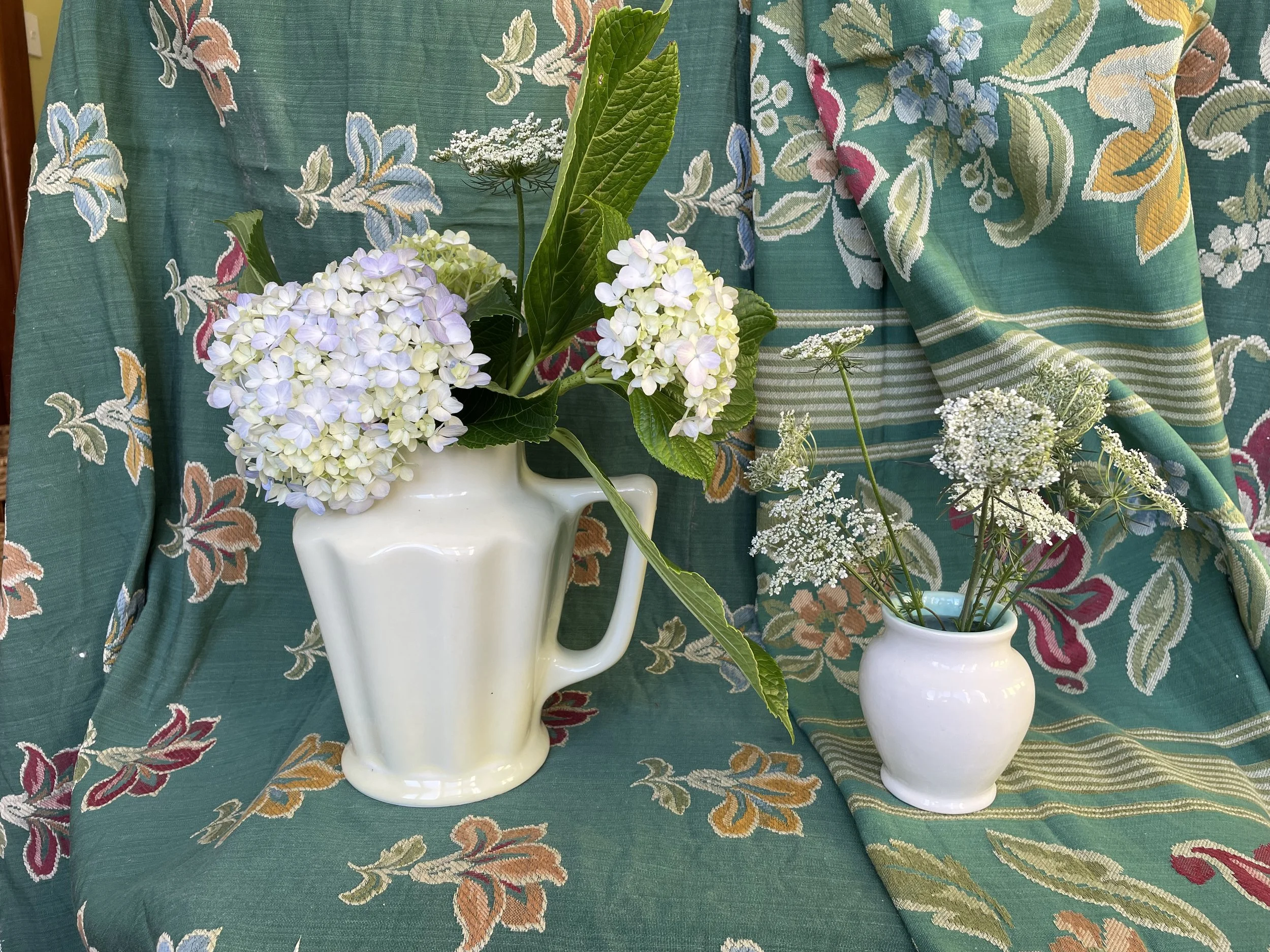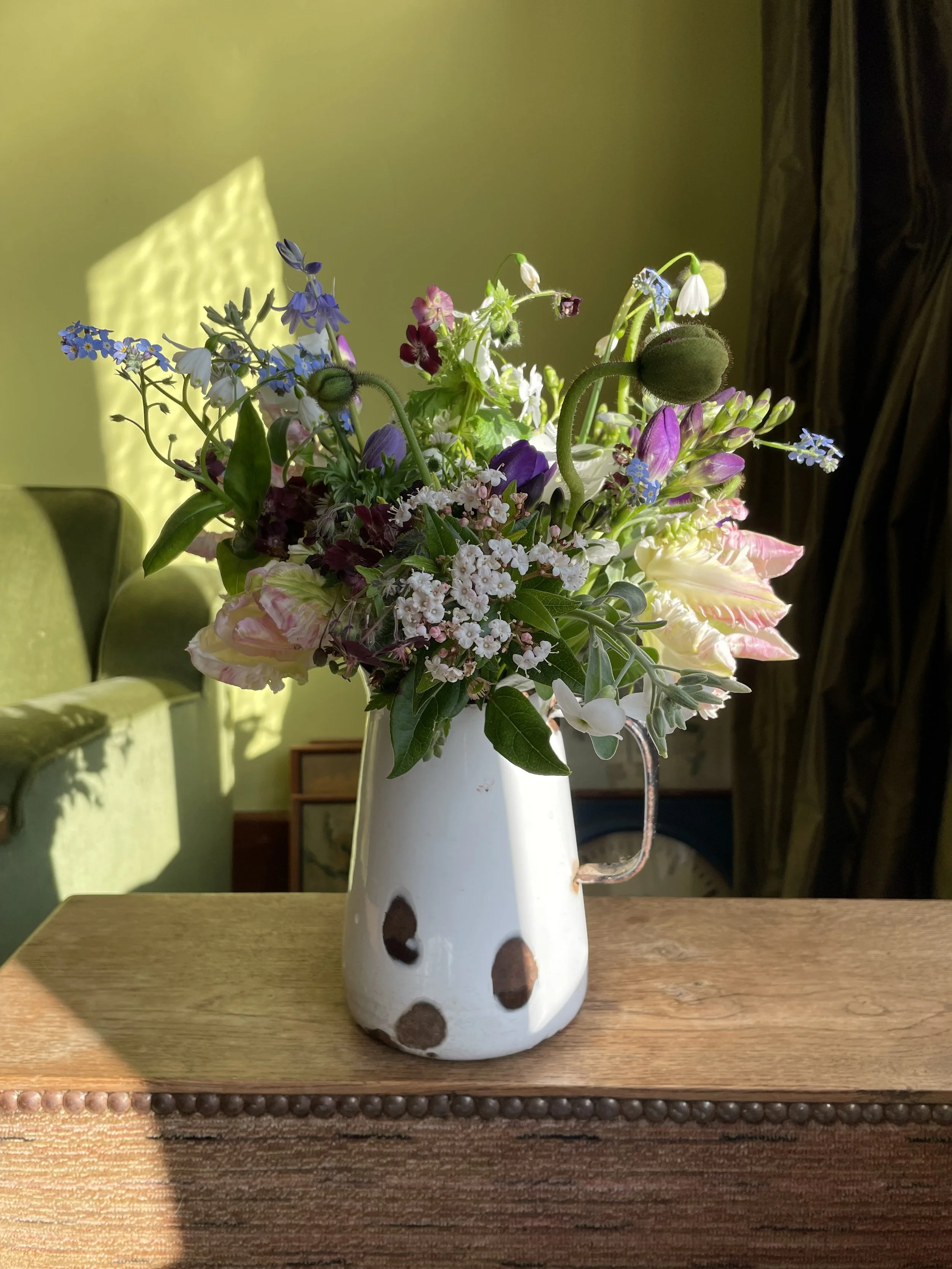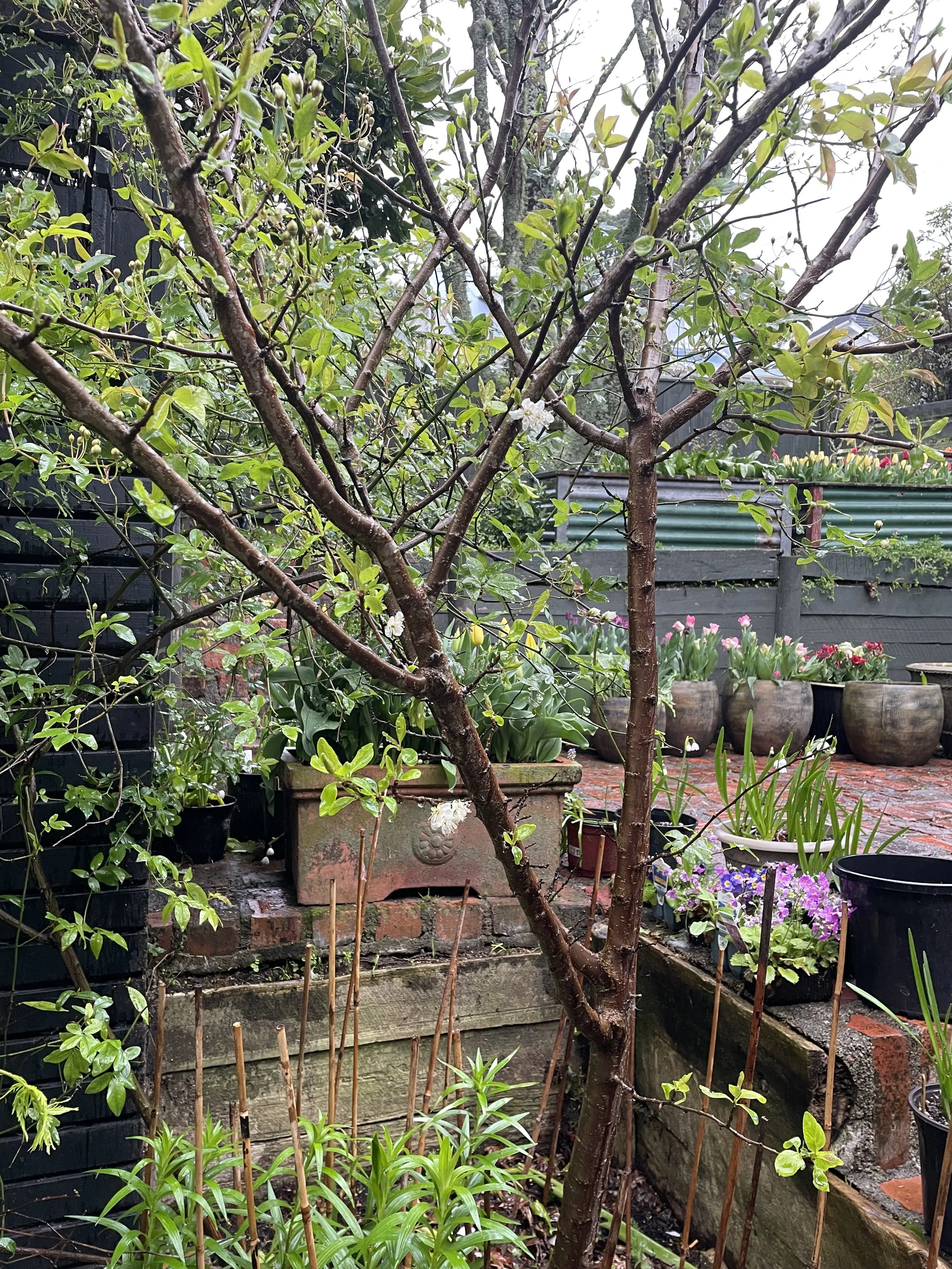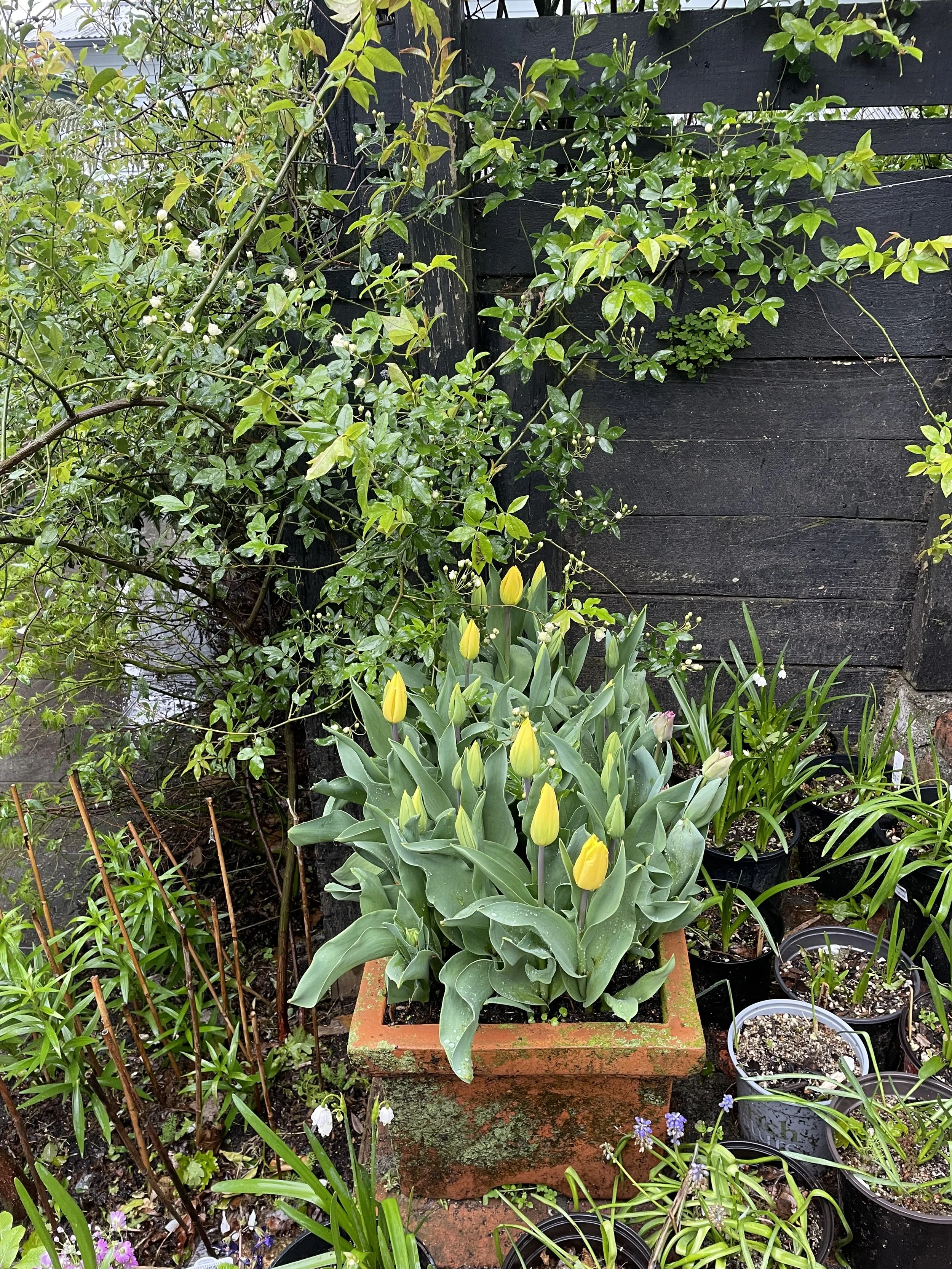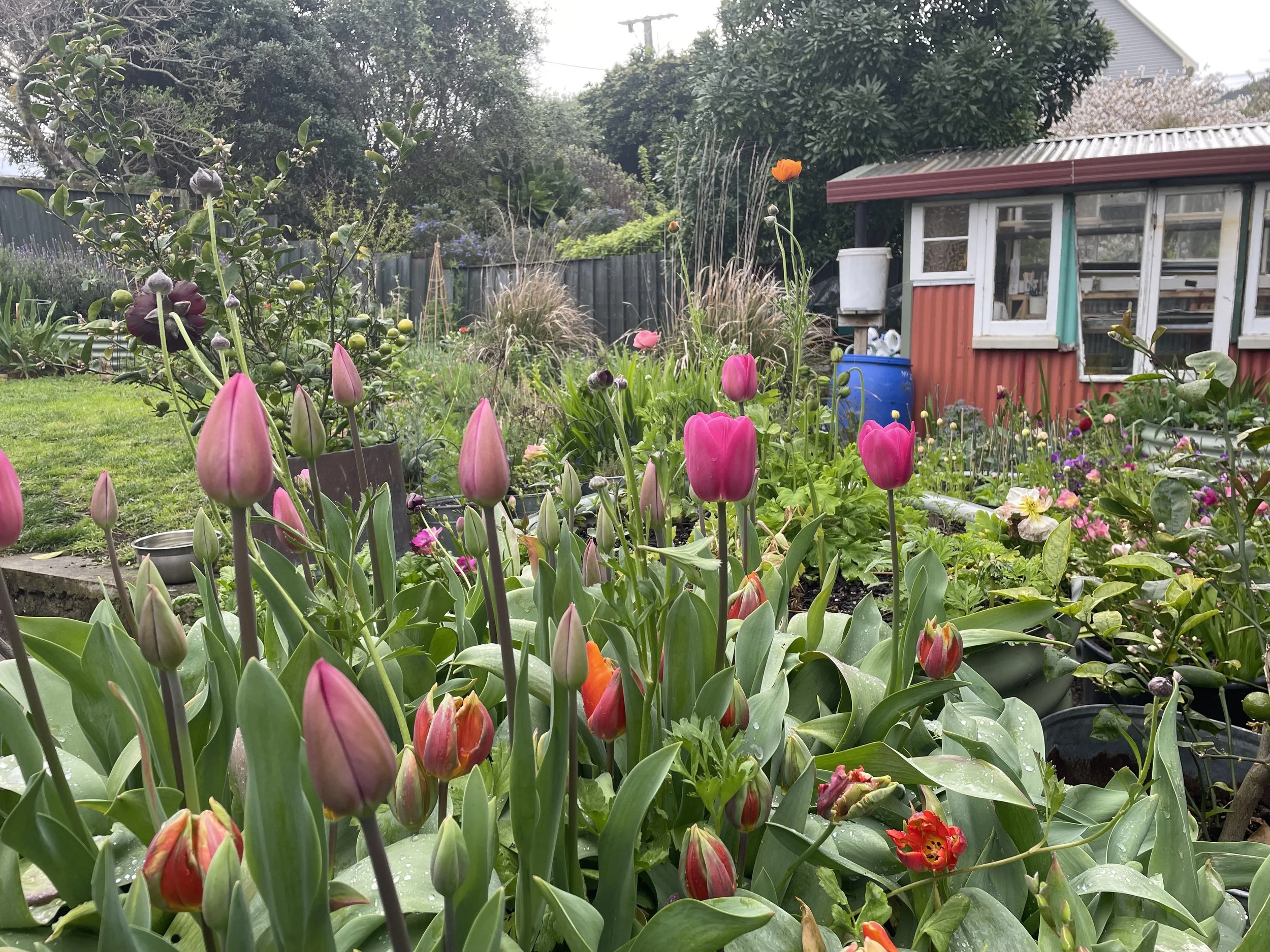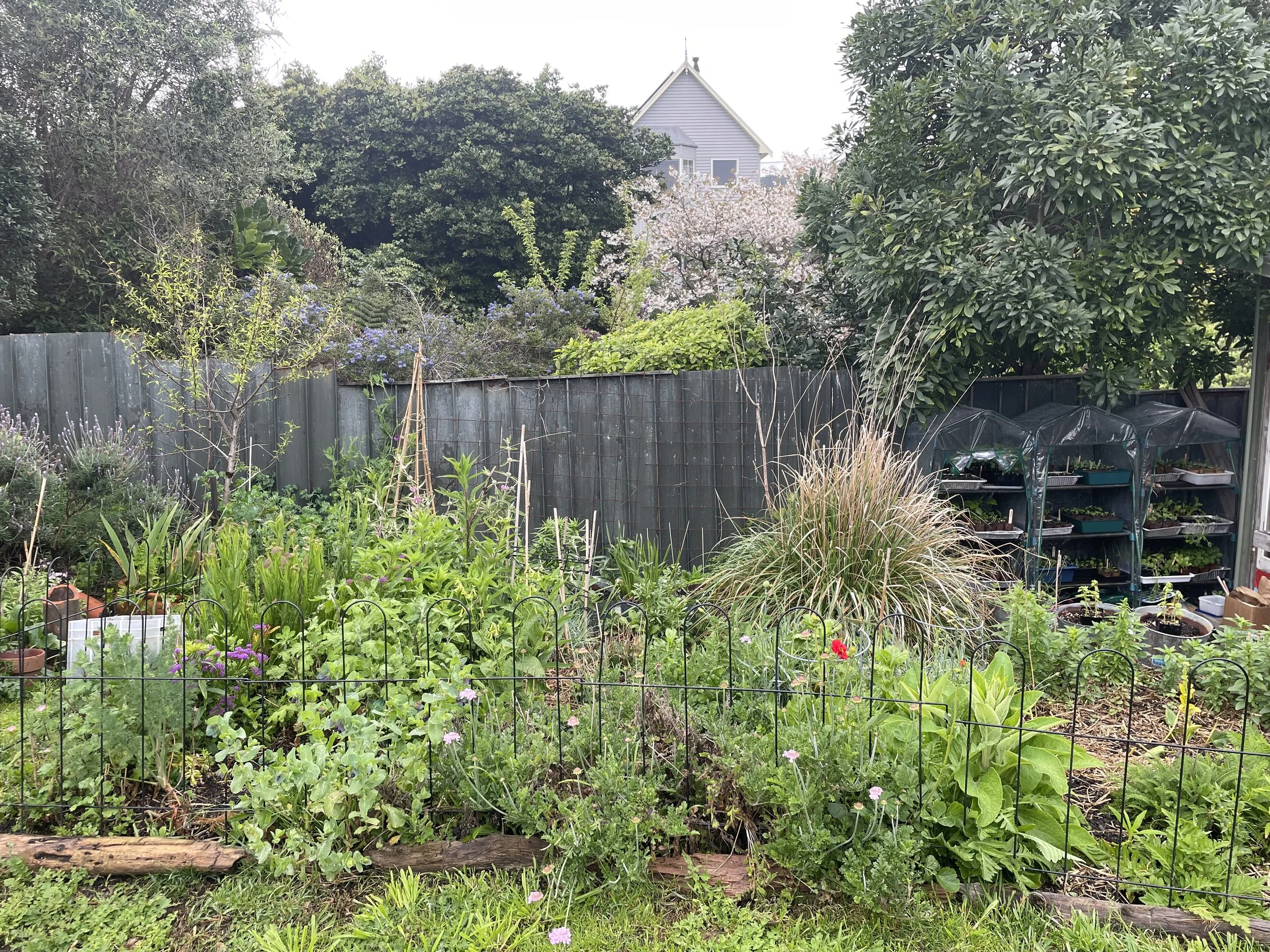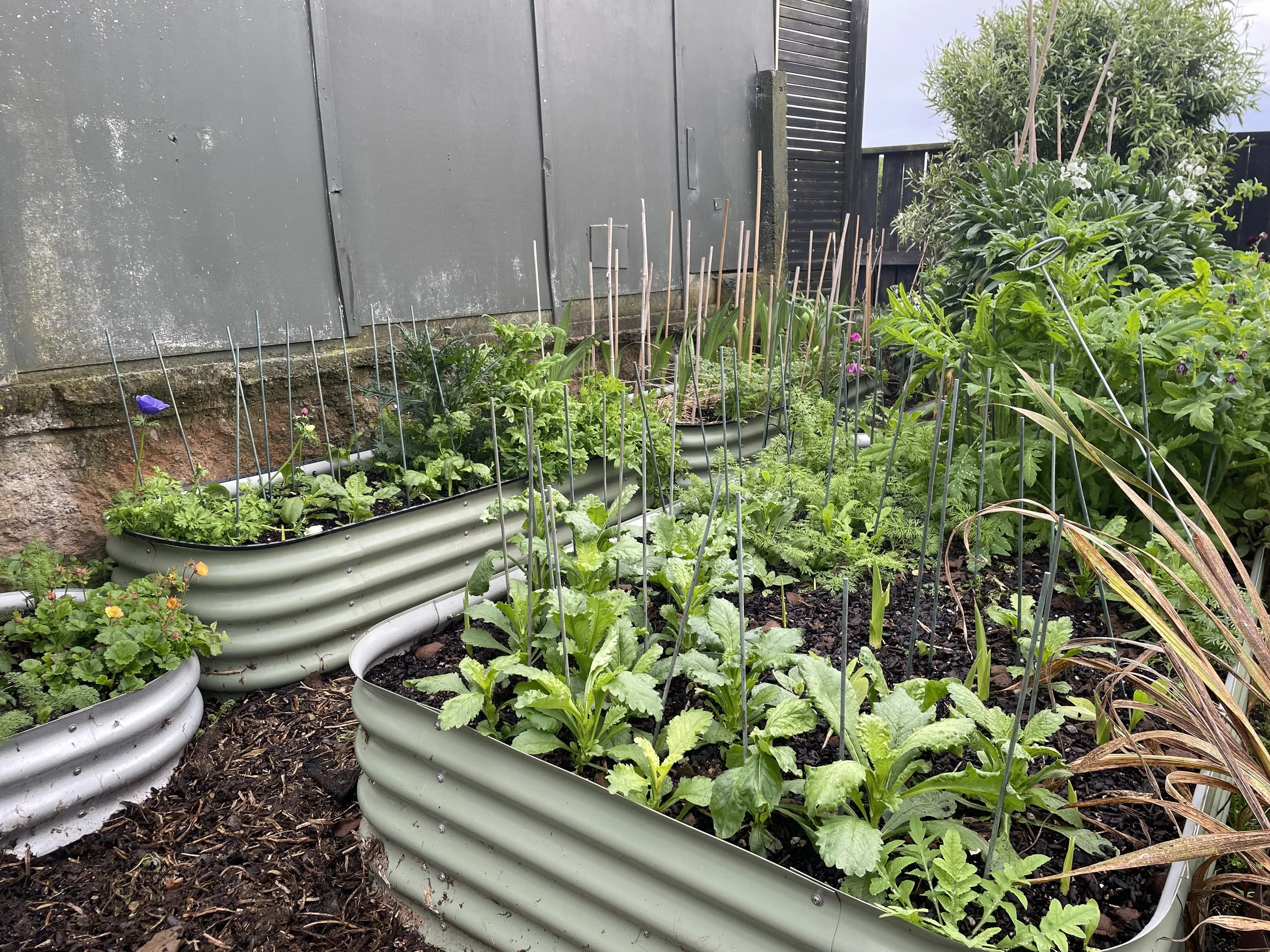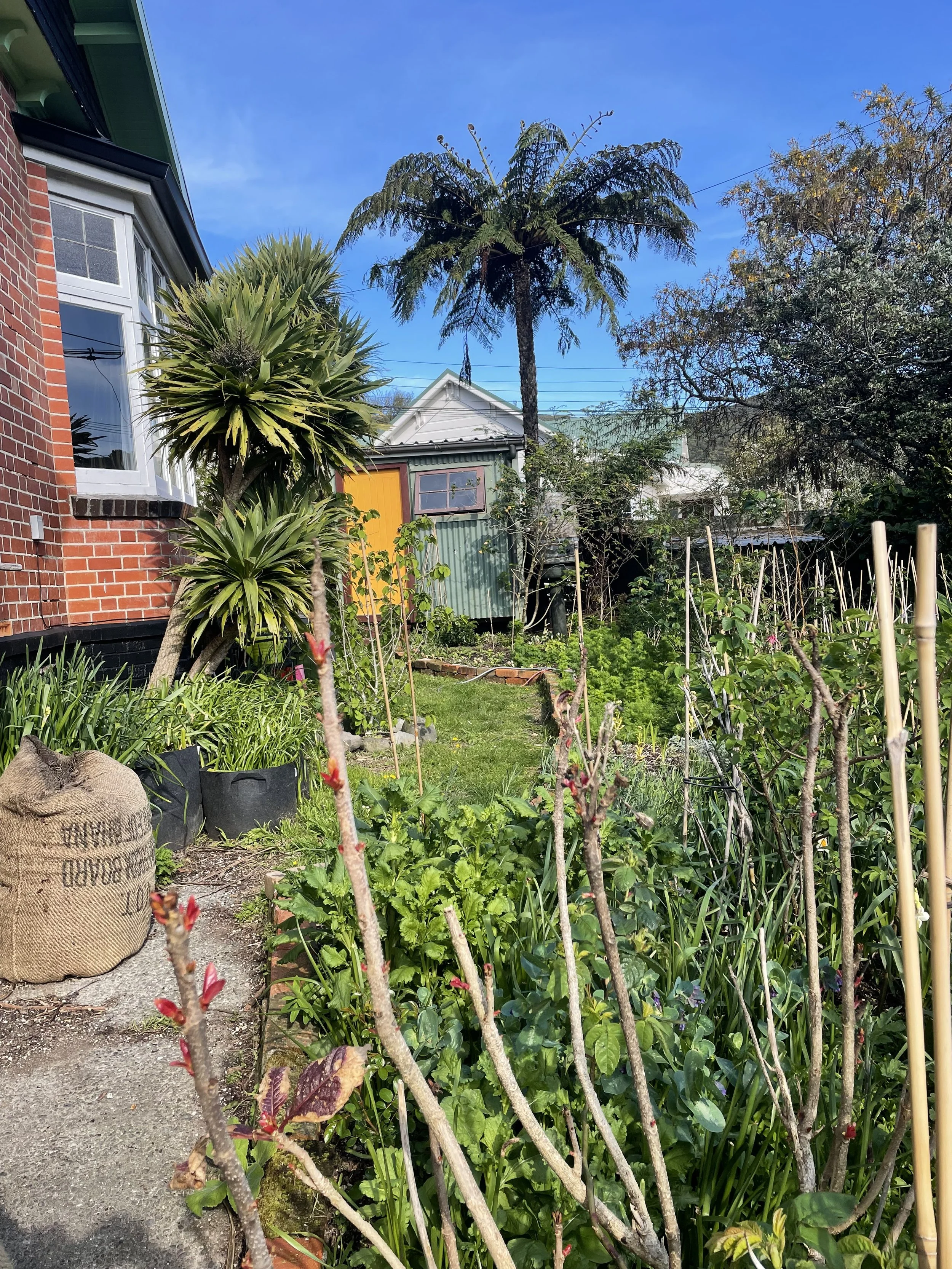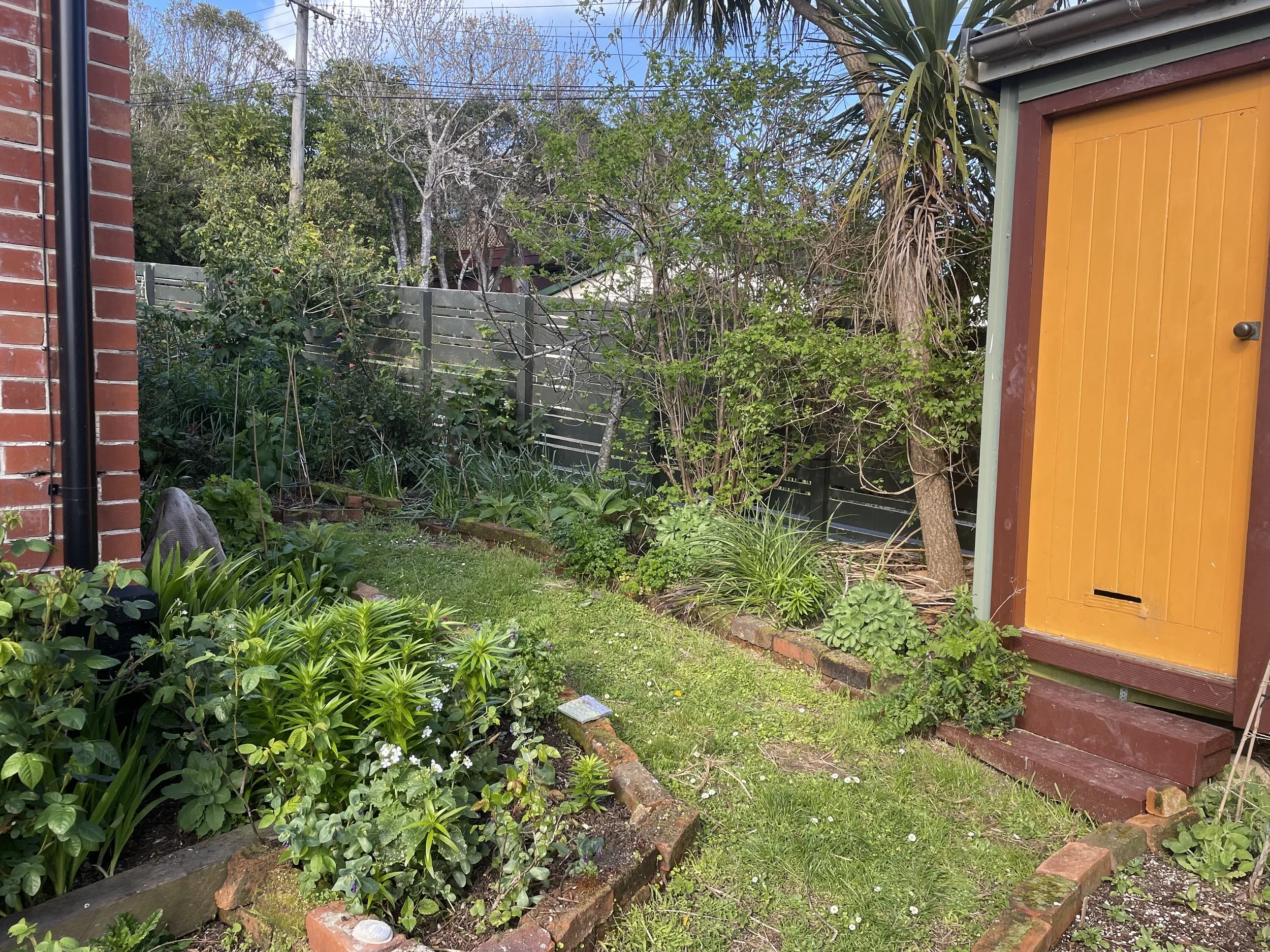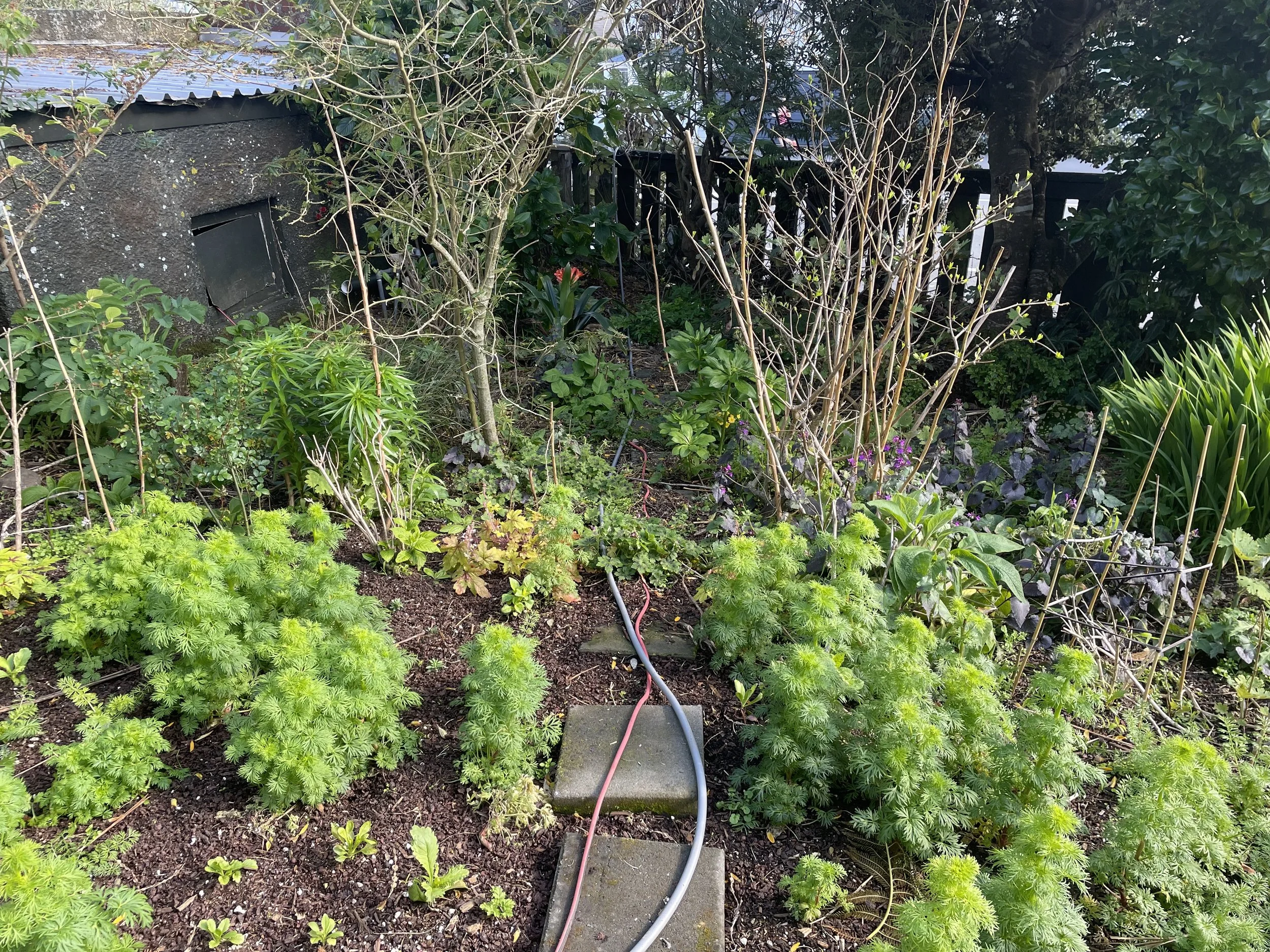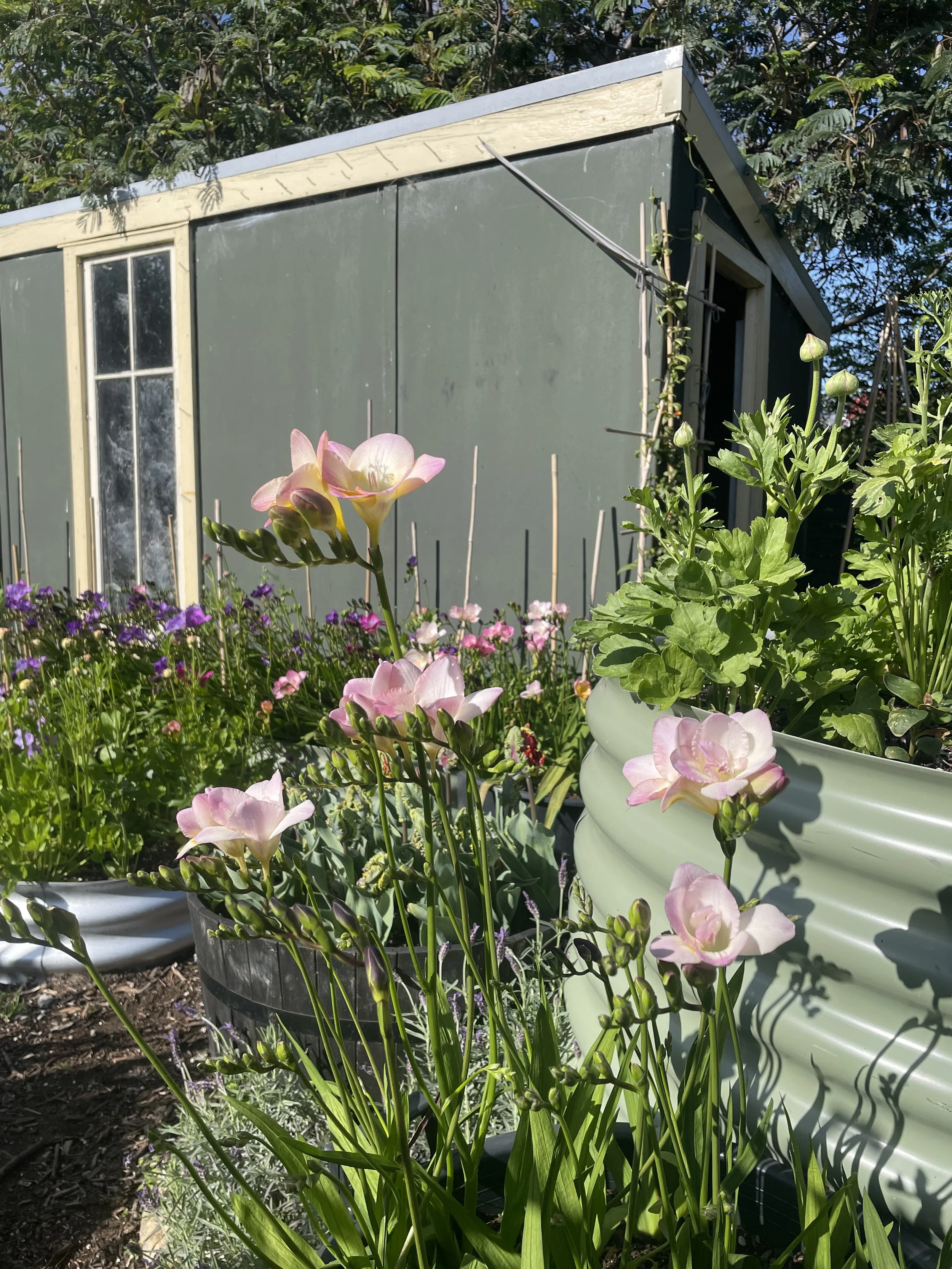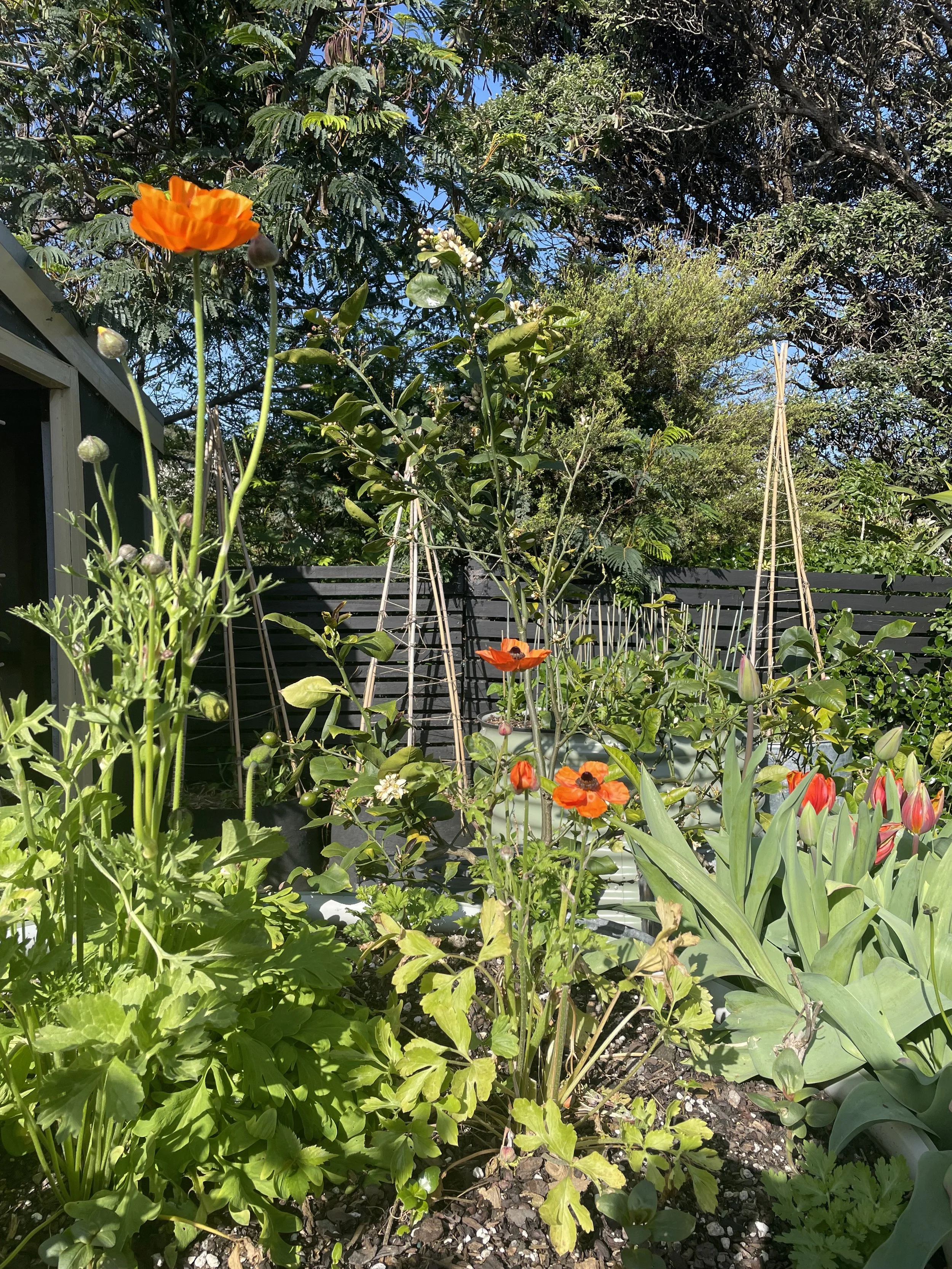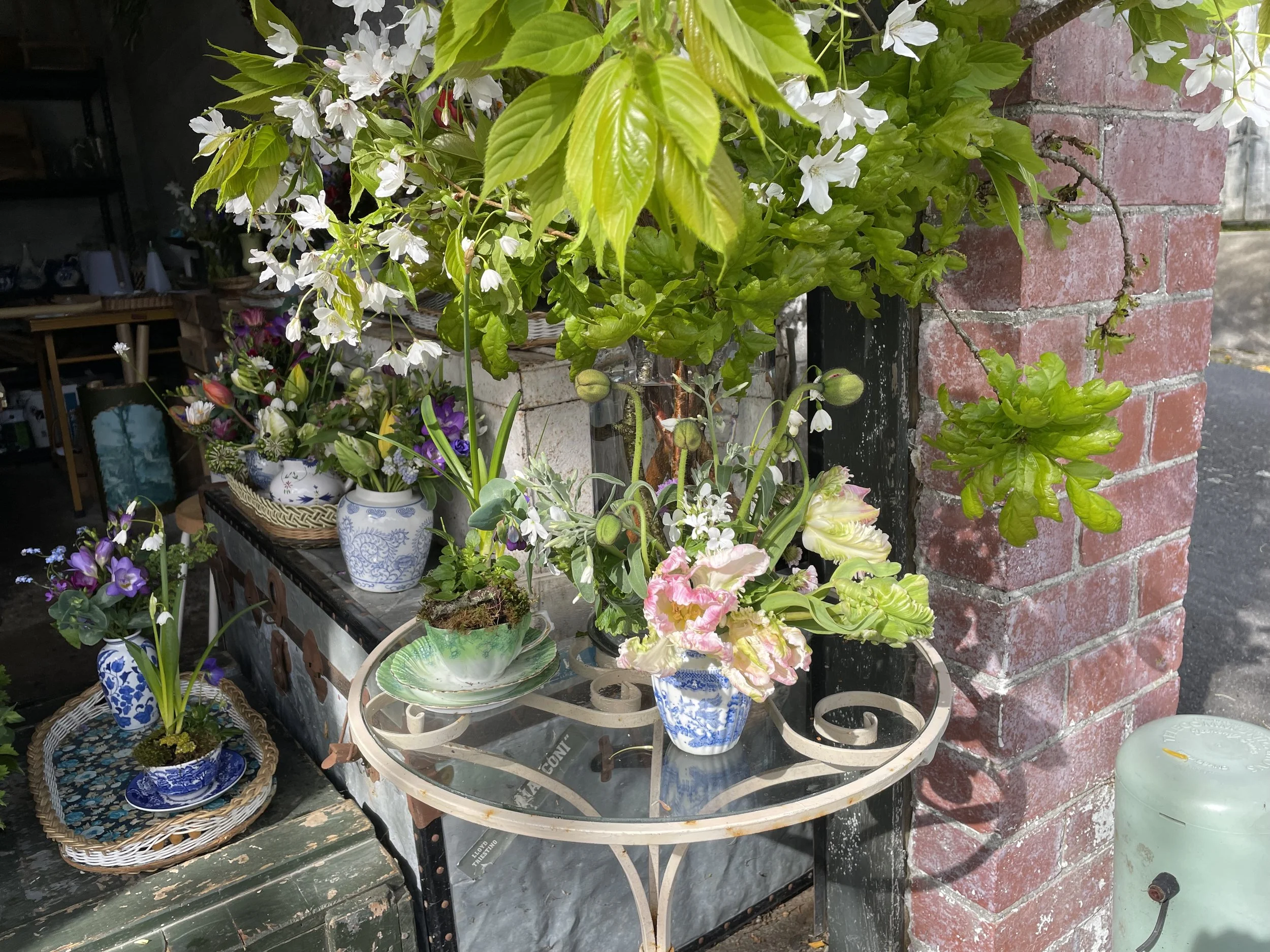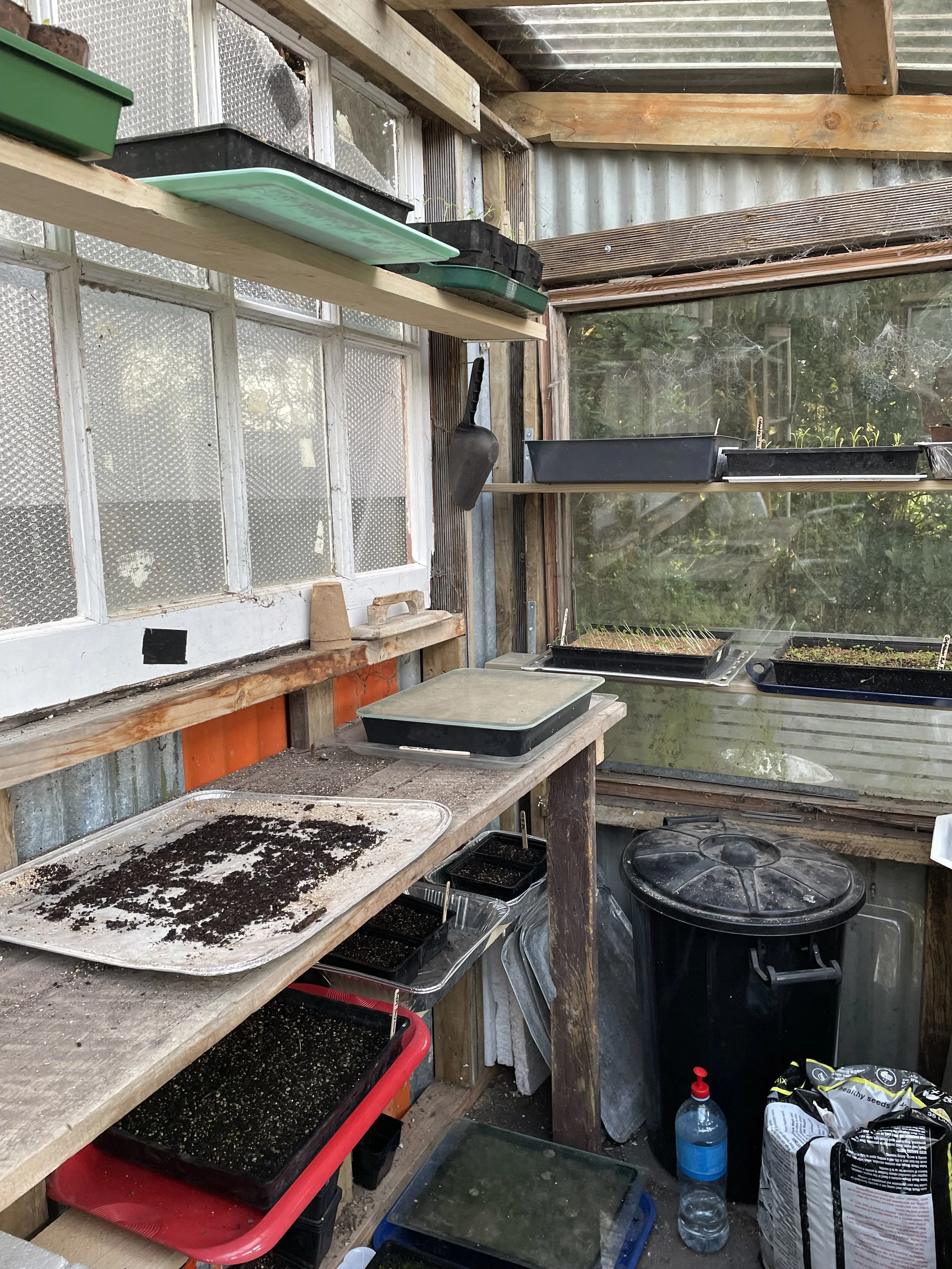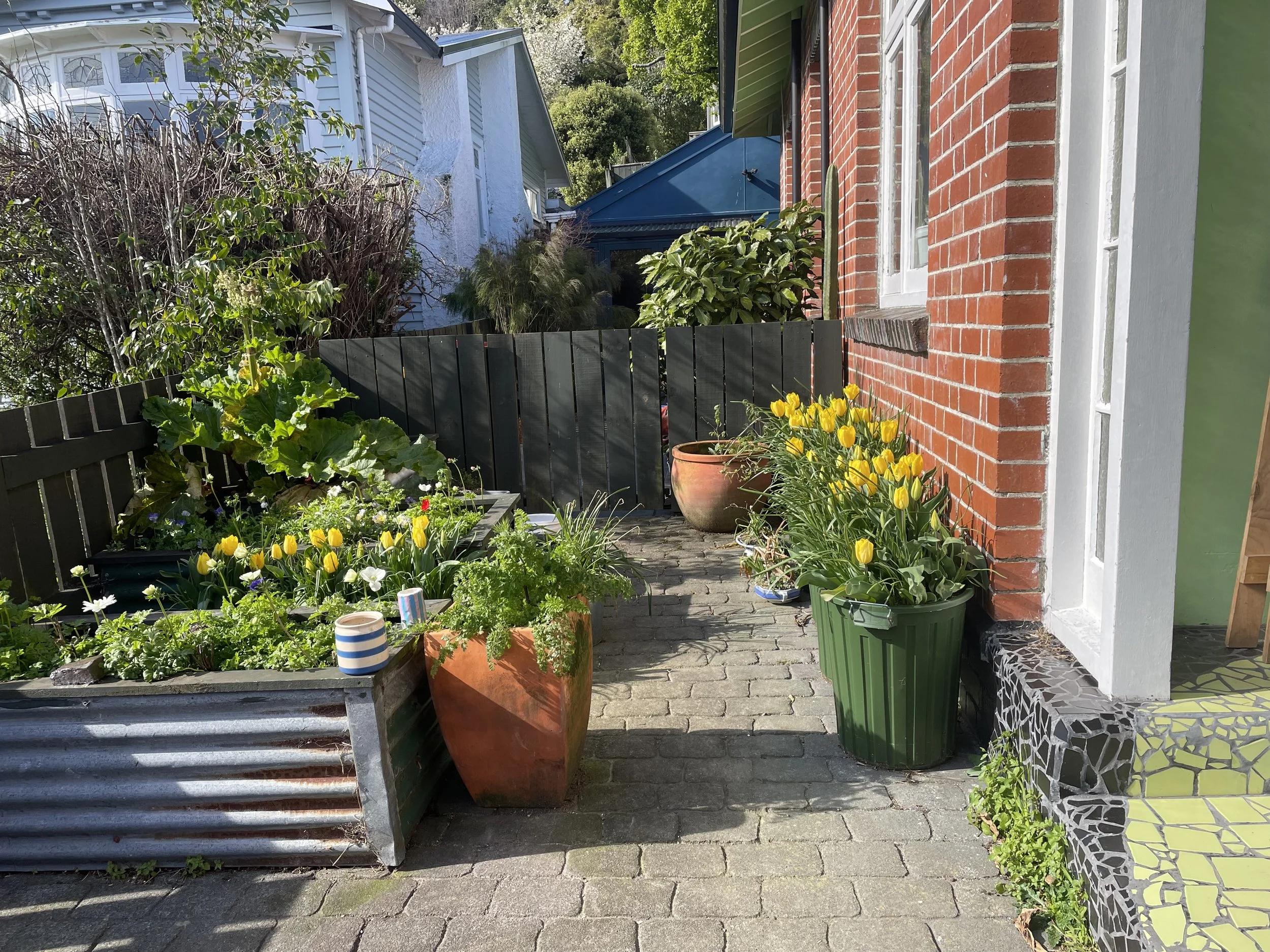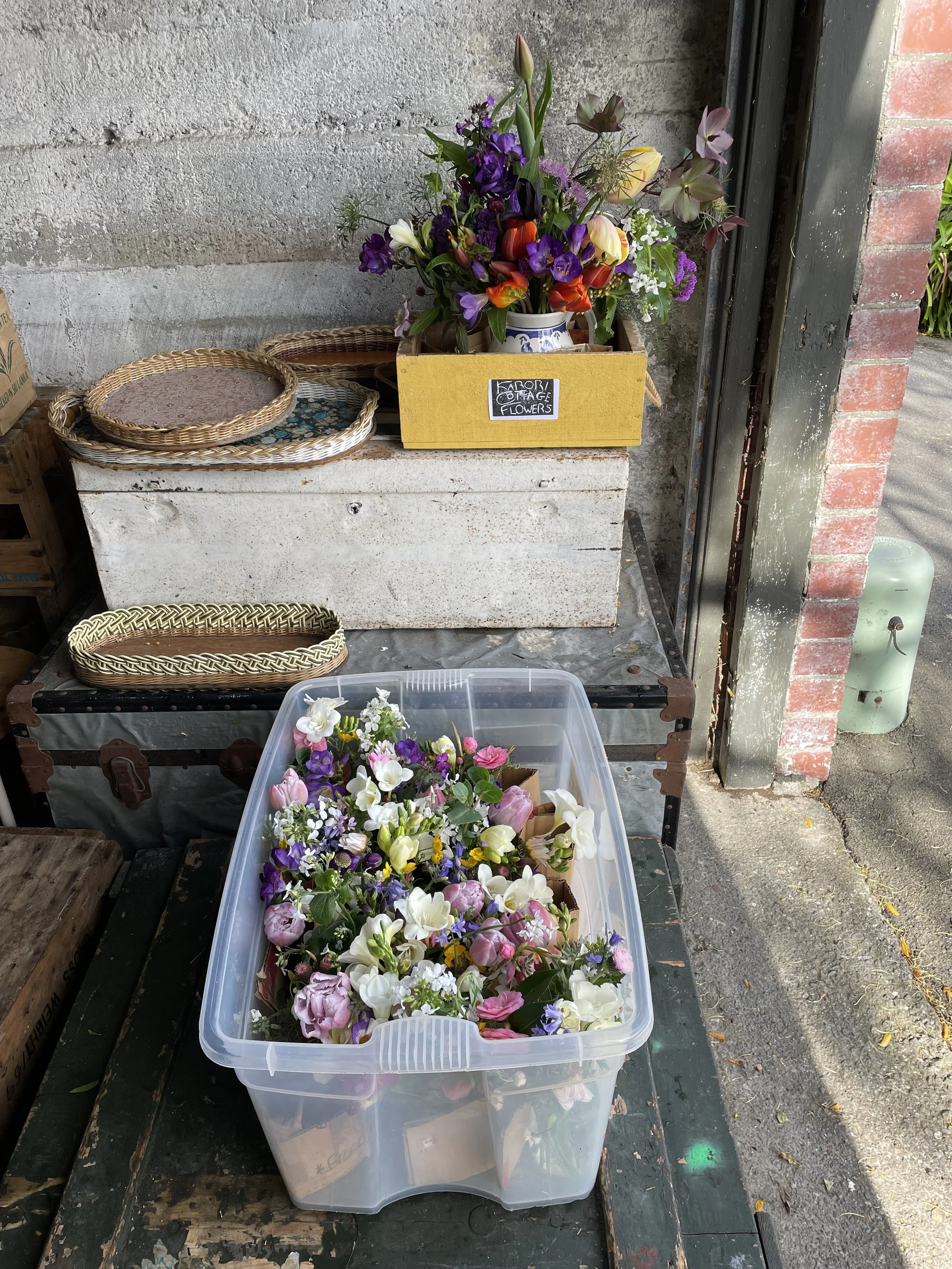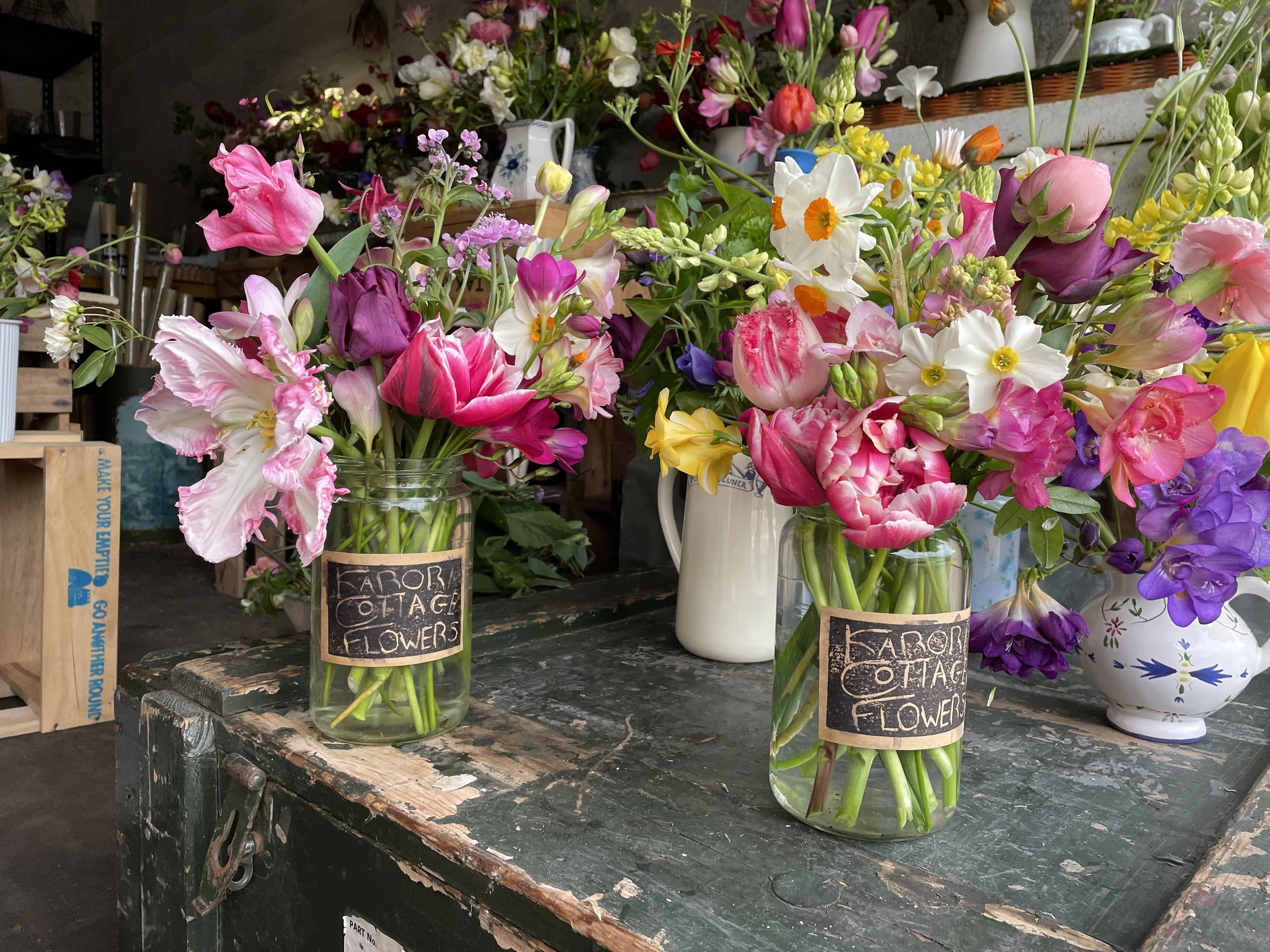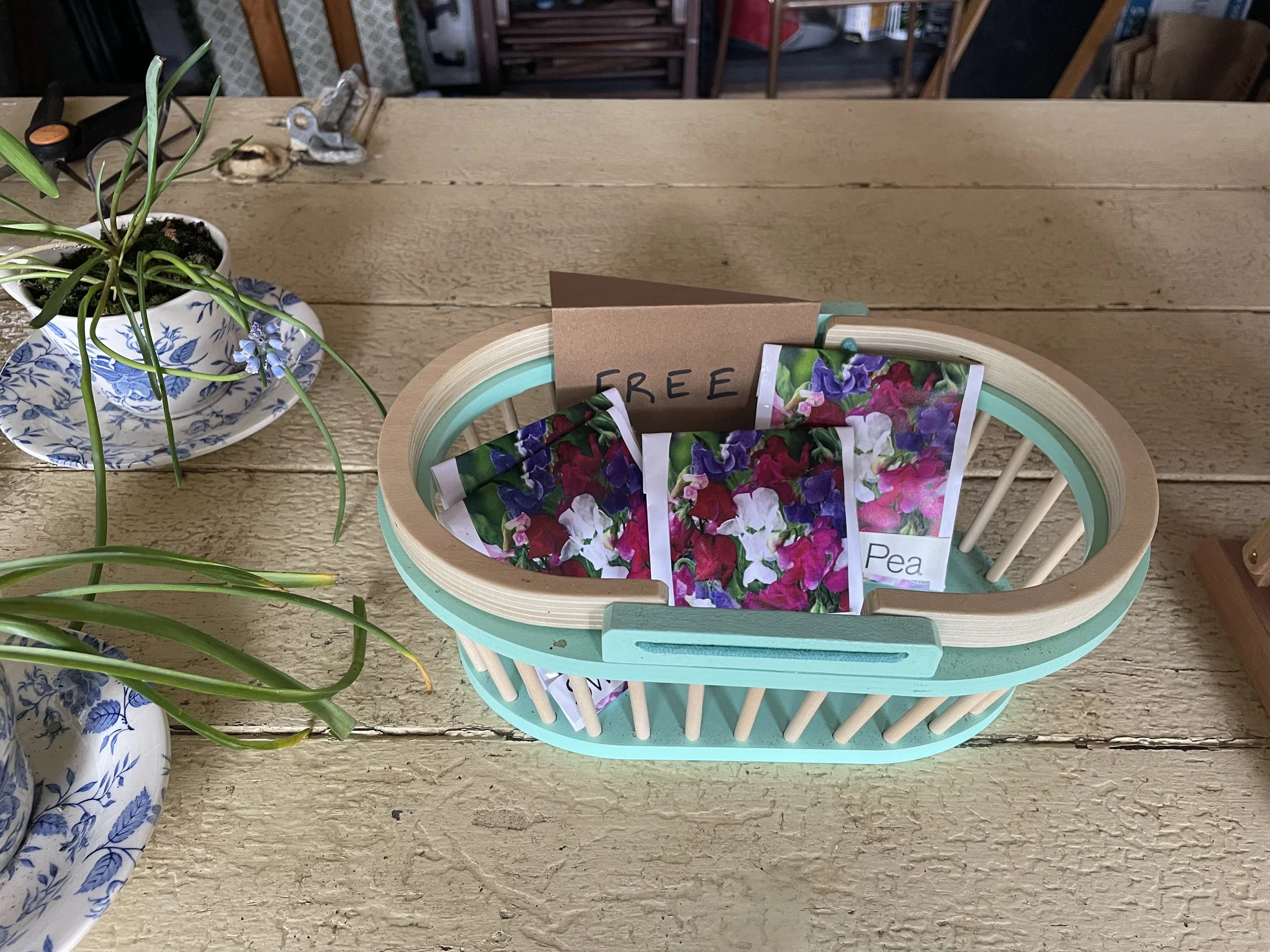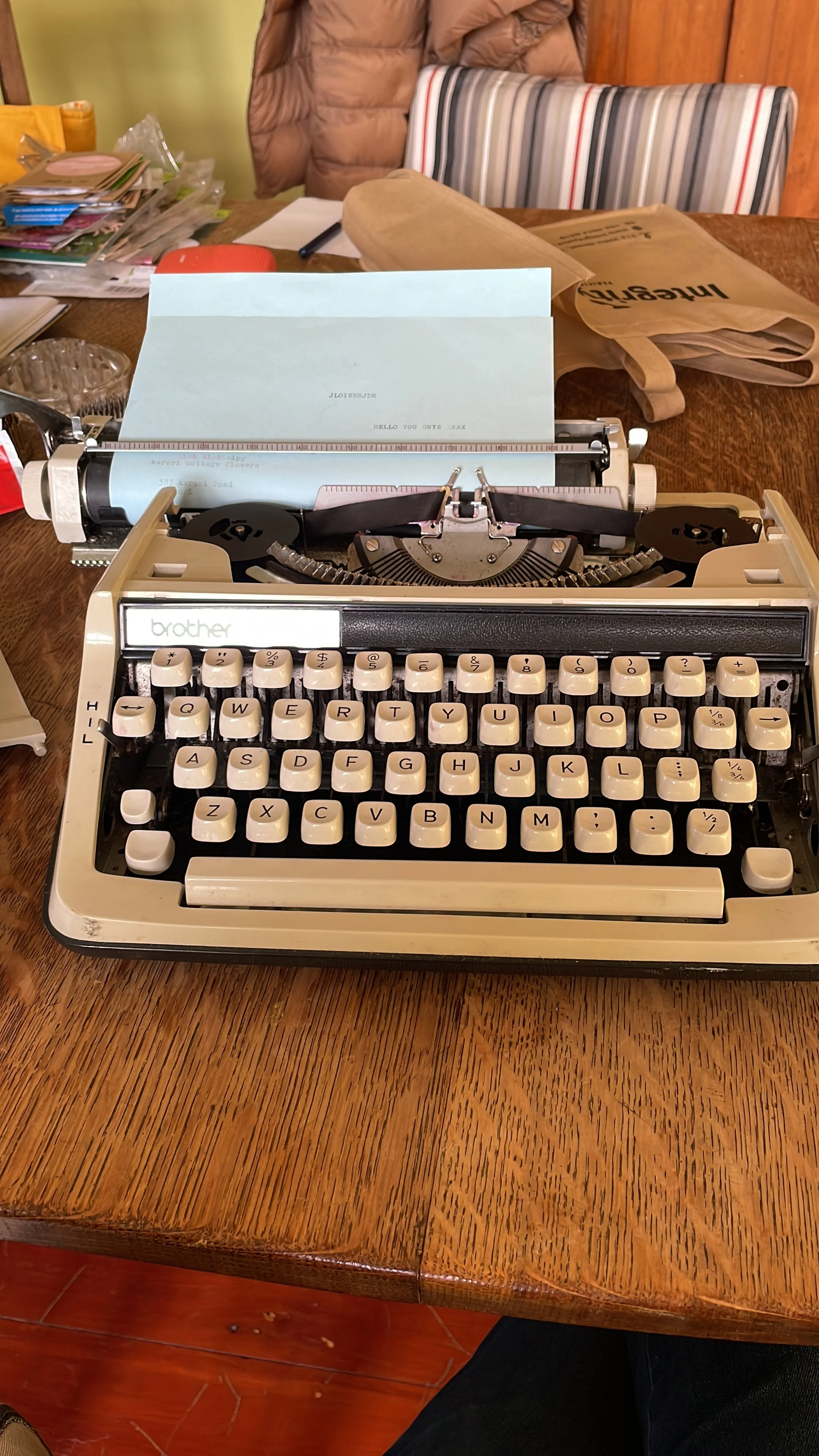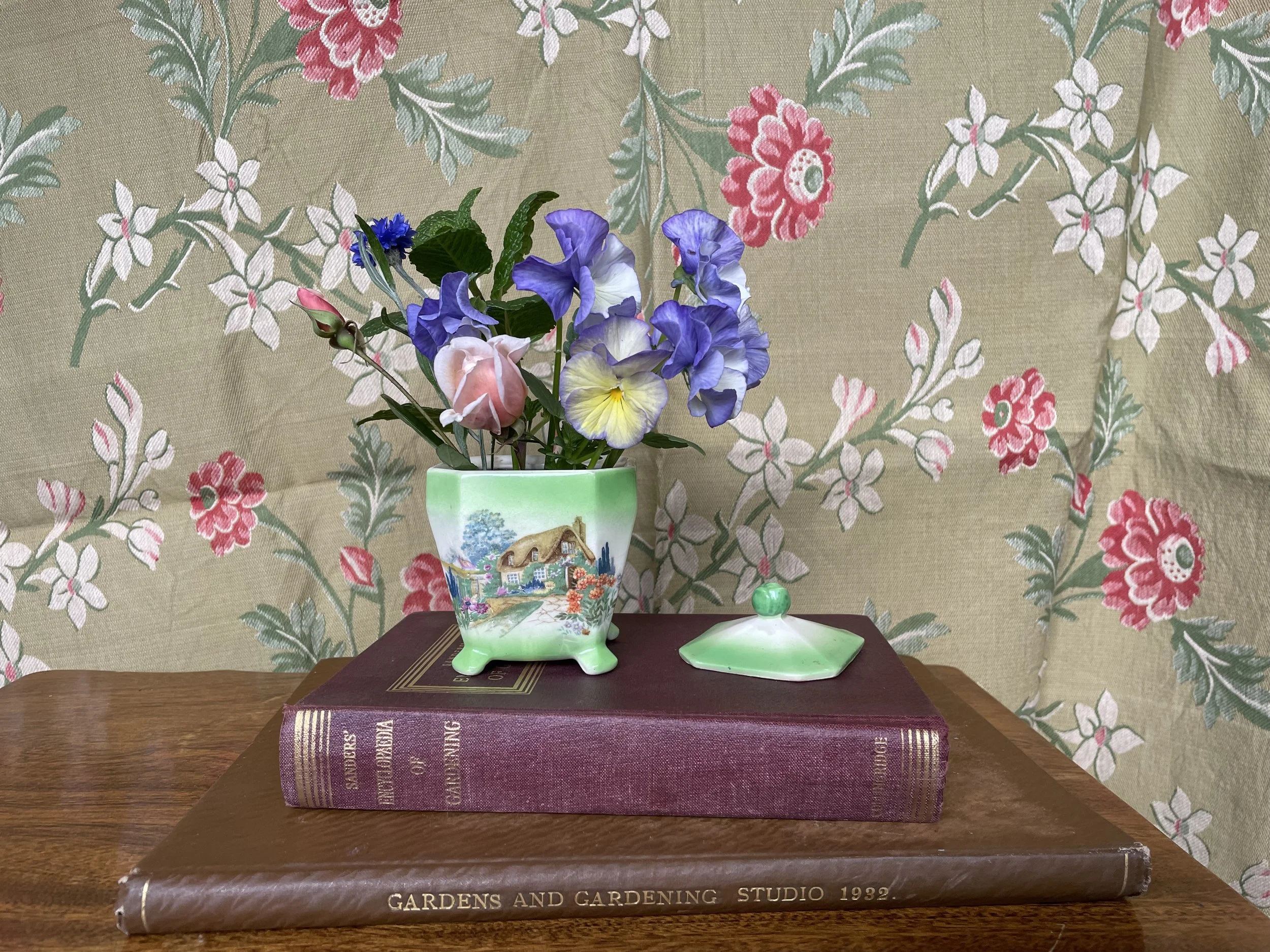It’s already 36 days into spring. It’s passing quickly. Far too quickly.
I spent all of winter looking forward to spring. And every daffodil leaf pushing up through the soil was a miracle. Every swelling bud on the greengage tree was cause for celebration.
The greengage tree in blossom.
Tulips and the first rose to flower.
Despite a gloomy winter of a recession, spring wasn’t cancelled. It was coming and nothing could stop it. Not Donald Trump, not the Wellington City Council, not even the White Witch. I don’t think I’ve ever needed spring so much. Maybe it’s this flower growing lark. Maybe it’s just that this year, which was supposed to be better than the last (and that year goes down as the worst in my 56 years), and it is better but there’s so much bad news in the world.
Anyway, it’s spring and I don’t want to waste time moaning when I could be noticing and savouring the most bounteous of springs. Our hundred year old oak tree in Karori is covered in leaves the most delicate shade of lime green. It is the colour of life, because between the leaves and lichen covered branches is the sky. The oak tree has caught patches of the bluest sky.
The back garden in Paekākāriki.
The back garden in Paekākāriki.
The back garden in Paekākāriki.
The front garden in Paekākāriki.
The front garden in Karori.
The side garden in Karori.
The small woodland garden in Karori and the corner of the shop.
Autumn and winter are busy times in the garden for flower growers. All the spring bulbs and hardy annuals are planted and sown. I listen to a lot of flower growing pod casts, and I mean a lot. When it’s nasty outside, it’s a real joy to be in my greenhouse sowing seeds and potting on seedlings, listening to one of my favourite podcasts, ‘Let’s Grow Girls’, a mug of tea by my side.
One of guests on LGG, was talking about hardy annuals. She said the ones sown and planted out in late autumn/winter produce better flowers than the same flowers sown and planted out in spring. The reason for this is that the winter planted seedling can concentrate on growing strong roots alone, rather than growing roots and stems and leaves in spring. And plants are in such a hurry in spring.
I reckon this explanation sums up a winter garden. It looks like nothing is happening. The beds are full of brown sticks. Even the green plants stop growing. Everything stands still. But some don’t. Under the soil, out of sight, the hardy annual roots are growing, reaching out and down. Grabbing onto food, air, water and space. Hardy annuals take advantage of the pause that all the other plants take.
Bearded iris's and Larkspur seedlings in Paekākāriki.
Here’s a list of my favourite late winter and spring plants.
Daffodils: such a wonderful variety of colour shape and scent, and they’re so damn cheerful. They aren’t fussy and come up every year. I want to grow more white ones next spring.
Tulips: so much style. Most flower growers grow them as annuals but Sophie and I refuse to do this. It does mean we have shorter flowers, but so what. I’m going to grow three times as many tulips next spring.
Anemones: so pretty and it’s very handy having flowers with long stems (some have short ones). I’m going to grow them from seed next year.
Sophie’s bluebells (mine were a disaster). They are just what is needed in every spring bunch.
Hellebores: the hero's of the season. Such a variety in exquisite shades, with long languorous stems. And when they last they really last. They dry interestingly too.
Freesias: I need to make supports for them next year so they don’t flop over.
Ranunculus: I thought they weren’t ever going to come, but they did and they’re beautiful and I don’t have enough. I’ll try and grow some from seed next year along with the anemones.
Honesty: one of my absolute favs. I’m going to sow seeds and plant out rather then relying on them to self-seed (which they do prolifically).
Freesias.
Ranunculus.
Foliage. Spring foliage to be precise. Sophie and I’ve been discussing this. We’re trying to find the right foliage. Most of what we’ve tried isn’t perfect. Foliage is important. It adds structure, it adds contrast. It stops the flowers flopping over in the vases. We’ve been using honeywort and while it’s pretty it’s too heavy, too dark. Almost everything is too heavy and too dark. So we’re on the hunt for just the right look. Something light and ferny or feathery. Jasmine is perfect so are forget-me-nots. So are maple leaves. Herbs are great too: mint, parsley and pineapple sage.
Spring foliage: oak and wild cherry.
Here’s a list of flowers that were disappointing.
Georgia’s bluebells. All foliage and no flower.
Second year tulips. I need to take them out of the raised beds and plant them in the garden. Some will die and some will grow new bulbs and flower.
There were some flowers that I sowed and nothing happened, like alium (because it’s tricky) and nicotiana (because the seeds were old).
The new shelves I built in the greenhouse (not the big one, but all the ones around it).
Here are some of the simple plant heroes that saved the bunches of flowers.
Forget-me-nots
Feverfew foliage
The little daisies that grow in the cracks in my driveway (whose name escapes me) and look pretty draped over the edge of a vase.
It's hard to see in this photo, but there are daisies growing along the side of the house in the cracks.
Sophie and I are finding our way with the flower shop. We think the future lies in subscription orders and events, while still opening the shop once a week and filling orders during the week. We don’t want to sell to florists or shops (only because we don’t have to). It does mean that sometimes we have flowers leftover after our Saturday shop, which we keep or give away. Our overheads are low. We don’t have to pay rent or lose 30% (or whatever the going rate is) off each bunch of flowers sold in someone else’s shop.
Flowers for an event.
Two subscription orders.
I was always jealous of people who loved their job. I never thought I was going to be that person. I didn’t think there was a job out there that encompassed the things that I love to do. Well I was wrong. This flower growing, flower creating, flower selling gig is that job. And yeah, some people think flowers are a luxury. But they’re wrong. Apart from the compelling argument that they provide food for pollinators, flowers make people happy. They’re the language of love and celebration and sympathy. They’re the gift we can give ourselves. and share with others. After living in Karori for 19 years, finally I feel part of the community. Since our shop opened Sophie and I have met so many wonderful people. We have so many loyal customers who recommend us and champion us. People have given us things too.
Sweet pea seedlings.
A lovely man, who made the plaster ceilings at Parliament (if remember rightly) gave us some beautiful concrete rabbits (which we are saving for Easter). A Karori gardener gave us packets of sweet pea and dahlia seeds (making the packets herself) that she’d harvested from her own garden (we gave the packets away for free to customers). And the mother of one of our gorgeous subscription customers sent us seeds and dahlia tubers from her Wanaka garden. Our community stretches far beyond the Karori boundaries now. I feel like we’ve started something special and we just need to keep on going.
The new shop typewriter for labels and other stuff.
Spring and All [By the road to the contagious hospital]
BY WILLIAM CARLOS WILLIAMS
I
By the road to the contagious hospital
under the surge of the blue
mottled clouds driven from the
northeast-a cold wind. Beyond, the
waste of broad, muddy fields
brown with dried weeds, standing and fallen
patches of standing water
the scattering of tall trees
All along the road the reddish
purplish, forked, upstanding, twiggy
stuff of bushes and small trees
with dead, brown leaves under them
leafless vines-
Lifeless in appearance, sluggish
dazed spring approaches-
They enter the new world naked,
cold, uncertain of all
save that they enter. All about them
the cold, familiar wind-
Now the grass, tomorrow
the stiff curl of wildcarrot leaf
One by one objects are defined-
It quickens: clarity, outline of leaf
But now the stark dignity of
entrance-Still, the profound change
has come upon them: rooted, they
grip down and begin to awaken
From Spring and All (New Directions). Copyright © 1962 by William Carlos Williams.
Spring in a vase.
